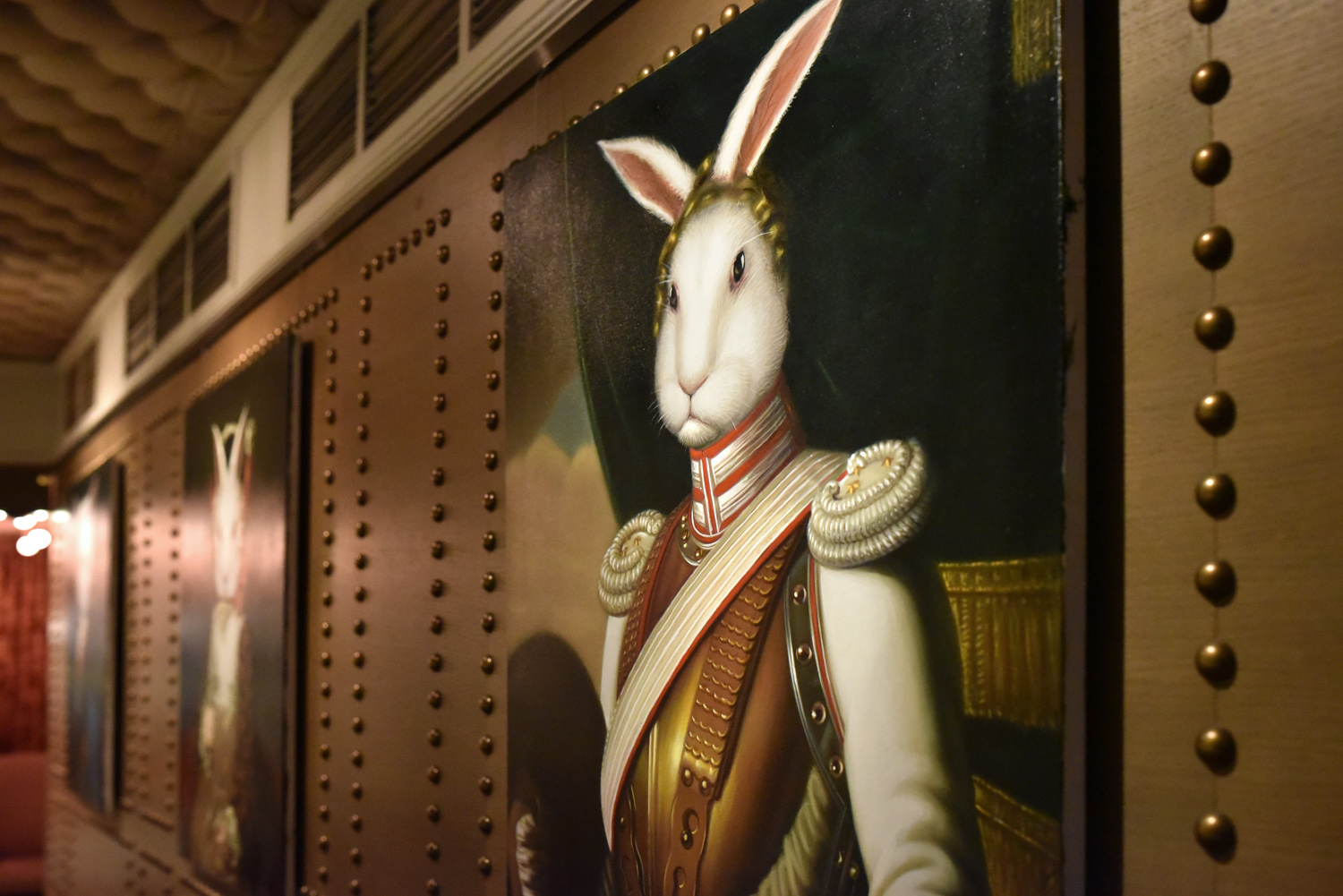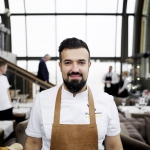Perched on the top of the Smolensky Passage, under a sort of glass dome, a few steps away from the Ministry of Foreign Affairs and the Arbat, White Rabbit is named after the famous rodent in Lewis Carroll’s Alice In Wonderland, which provides inspiration for most of the interior design. The restaurant is both aptly positioned and aptly named, as it’s a sort of UFO in the Russian dining landscape, intent on showing its patrons the “other side” of Russian cuisine.
High-end Russian restaurants actually remain a relative rarity in a country where haute cuisine too often means French or Italian. This is the case even in the high-rolling capital city, Moscow. After all, excellent national dishes can be had at unpretentious eateries all around town for a mere handful of rubles, and in most people’s minds — perhaps because the Homo Sovieticus had pretty much only one cookbook — a chef who claims to make Russian cuisine must serve the same traditional dishes as everyone else.
Furthermore, while a certain few Russian ingredients such as caviar or king crab often call for high prices and attract well-off patrons, this is not where the restaurant’s emphasis lies. These ingredients do appear on the menu, but not always as one would expect them. Caviar is served with Russian black bread, crab in a kholodets aspic, and truffle (Crimean) with elk stew. There are live crabs from Kamchatka in an aquarium, but no expensive caviars served with various accoutrements in precious little ramekins. On the other hand, you might find veal tongue, rabbit tongues, moose lips, swan livers, herring milt, sea asparagus, whelks, birch bread (made with the bast fiber of birch trees), and lots of berries and mushrooms you’ve never heard of.
This unconventional approach is the work of thirty-something chef Vladimir Mukhin, one of the leading advocates of New Russian cuisine (as in Russian cuisine that’s new, not cuisine for New Russians). You can read more about Mukhin in this article, but I find that this quote (found here) defines him pretty well:
I am the fifth generation of chefs in my family; Russian cuisine is in my blood. I am inspired by local products, many of which are unknown abroad, as well as our native cooking techniques: the languorous process of cooking in a Russian oven, fish drying, curing, brining.
In 2014, White Rabbit benefited from an unexpected turn of events that would go some way towards decreasing diners’ cognitive dissonance: Putin’s embargo on most foodstuffs imported from the E.U. and the U.S (and a few others). Mukhin was already sourcing most of his ingredients from the Motherland, and now everyone else had to do the same, and start playing catch-up. White Rabbit found itself at a new gastronomical forefront that even a thick-skulled, uncultured, chauvinistic nouveau riche could understand. Crimean truffles, Black Sea and Siberian shellfish, corn-fed Russian beef, cheese from the Volga region and beyond… “In 10 years, domestic food products ought to replace and squeeze out imported ones 100 percent,” said the Minister of Agriculture, expanding on Putin’s gospel.
But White Rabbit also delivers in terms of quality and execution: it has been on The World’s 50 Best Restaurants list for 4 years. In 2018, it climbed to the 15th spot, the highest result ever reached by a Russian restaurant. Mukhin is gaining international fame, and is even featured in Season 3 of Netflix’s series Chef’s Table. To paraphrase the restaurant’s web site, Mukhin’s goal is to apply the latest gastronomical trends to Russian cuisine, using Russian products elevated to the rank of delicacies, while preserving a careful relation to traditions. All of this leads some [Russian] people to think that the next global ethnic food trend will be Russian cuisine. (Considering Russia’s relationship with the rest of the word at this time? I have my doubts.)
Local seasonal products, rare ingredients you’ve never tried before, great execution… But few people seem to mention the many thought-provoking pairings that appear on the menu: foie gras and herring on toasted brioche; scallop with raspberry and brined tomatoes; sea urchin roe with sea buckthorn and sea water. There are only so many dishes I was able to try during my visit, and I don’t agree with every pairing, but Mukhin’s willingness to experiment is commendable.
The menu is quite long for a restaurant of this caliber: four full pages, organized into shellfish, small bites, cold appetizers, salads, hot appetizers, kashas, soups, pirozhki, truffles, fish and seafood, meat and poultry, on the fire, vegetables, desserts, candies and cookies, ice creams and sorbets, preserves and honey. For a total of almost a hundred dishes, plus the tasting menu. Phew!!

The cocktail list is almost as long as the menu, though one entry offers an easy alternative to decision fatigue: the eponymous White Rabbit cocktail (red currant, apple, sake, apple liqueur, carrot juice). I’ll have one, please. This turns out to be a strange choice from the mixologist, as the concoction is somewhat average — not very strong, a bit too sweet, with a nondescript berry taste. Surely some of the other drinks are more interesting than this?
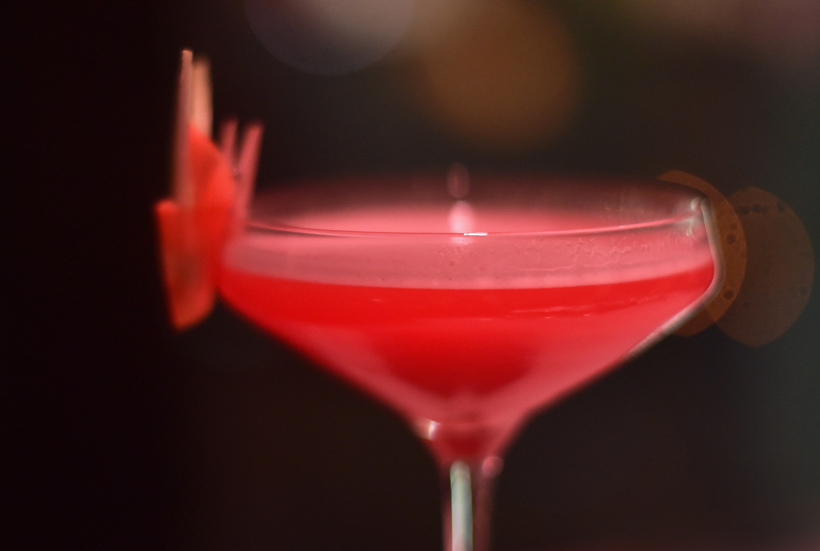
But let’s start tasting the food. The pastrami of veal tongue, baby spinach, fried oyster mushrooms, and avocado is tossed table-side in a little bowl. The veal tongue is excellent, so tender it melts in your mouth. The vegetables — the above mentioned plus cucumber and tomato, to boost the Russian-ness — are combined in a sweet and sour sauce. Very spicy; a little bit Chinese, which is unexpected but goes well; maybe it could be less sweet and more acidic.
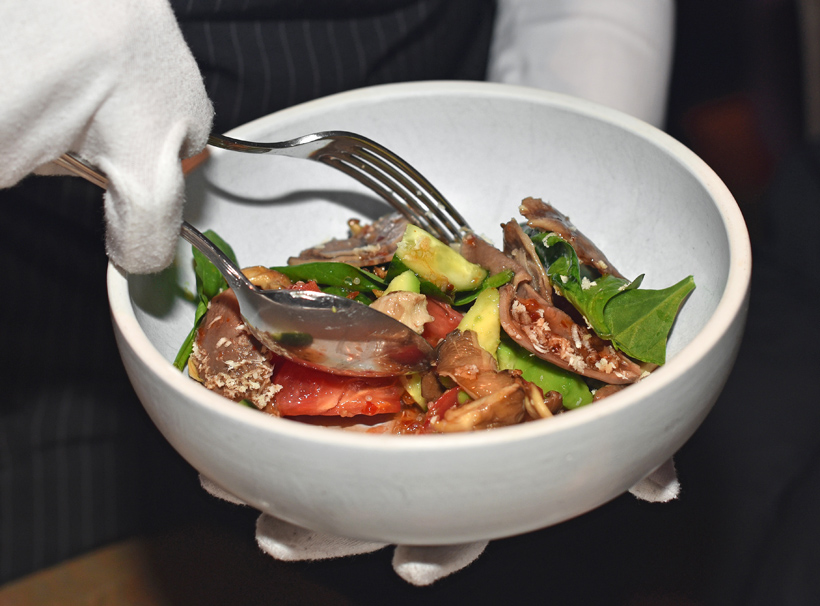
The savory napoleon with caviar, one of White Rabbit’s most famous dishes, consists of Borodinsky bread cut very, very thinly, spread with butter, then stacked into about eight layers and topped with a little bit of sturgeon caviar. The napoleon is a good idea, but I feel like the taste of the caviar is almost completely masked by the black bread — I would go for something with a more assertive taste, like salmon roe.

The brioche, herring, and foie gras is a very original pairing idea, marrying a poor man’s staple from the sea with a meat offal delicacy, on top of a frou-frou bread. And it works great! The herring is perfect; not too salty, and melt-in-your-mouth tender. The foie gras is foie gras, and I would put a little more of it, but I imagine that because most foie gras-producing countries come under Putin’s embargo, it’s become even more of a luxury than it already was. The little toasts are sprinkled with scallions and something that might be black sea salt.
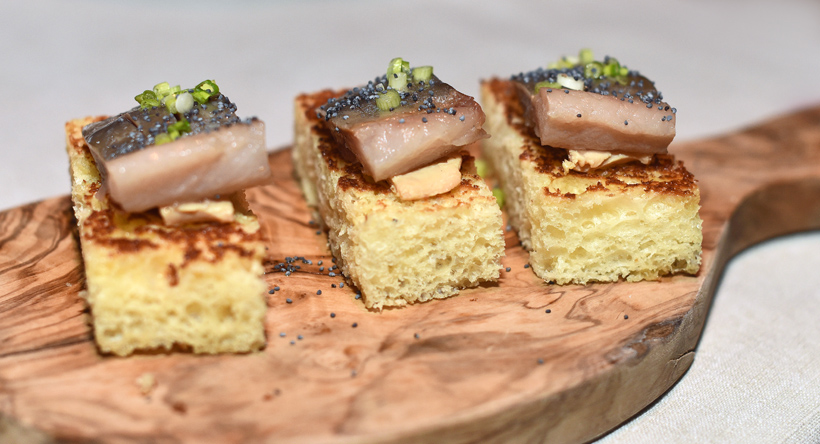
The elk, sunchoke, and truffle is elk stew covered with sunchoke purée, sunchoke chips, shaved black truffle, and mysterious crunchy white dice that I never identified. This time the pairing is more conventional (game, root vegetable, mushroom), but the execution really stands out. The stewed meat, shredded into small pieces, is very flavorful, and it’s enhanced by the sauce, which is most likely made from the heavily reduced stew liquid finished with a little bit of port wine. Both the sunchoke purée and the little sunchoke chips really taste like sunchoke. I don’t remember being wowed by the Crimean truffle, but this is still one of my favorite dishes of the meal.

The Stroganoff of whelk and parsley root purée follows the same schema (stew, root vegetable purée, mysterious crunchy white dice), although there isn’t any hint of this on the menu. I’m not sure why it’s called Stroganoff. Maybe because of the cream sauce with diced tomato? Wait, do I see a few mushroom cubes in my picture? They were totally missed in the darkness of the dining room. Anyway, beef Stroganoff is already very loosely defined, so once you remove the beef, you can pretty much apply the name to any dish with cream. The whelk, cut into a fine julienne and cooked in the Stroganoff-ish sauce, will be a novelty for most diners, be they Russian or foreign. It’s a little rubbery, as expected from such a mollusk, but still tender. It doesn’t have a whole lot of taste in itself, but luckily the excellent parsley root purée contributes plenty of flavor.
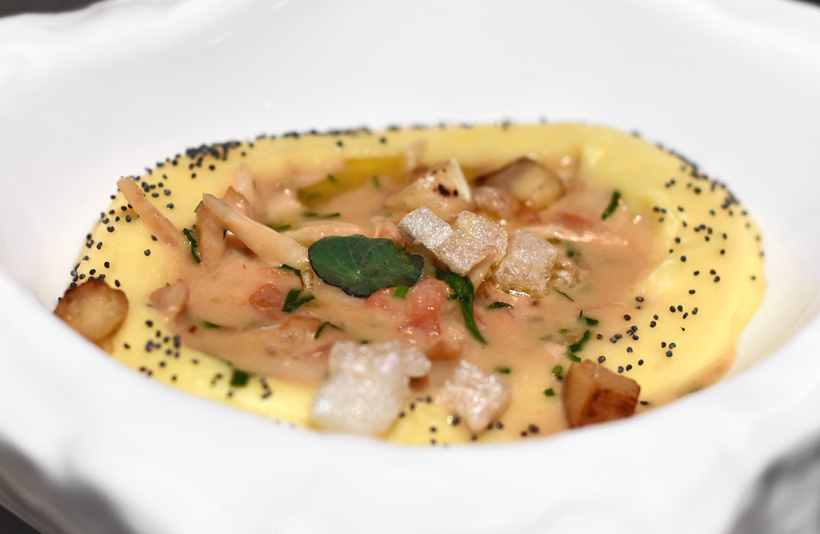
The wild boar cutlets, celery root purée, and rowanberry jelly is a delicious take on the typical Russian meat cutlets. I believe that the cutlets, which look more like meatballs, are wrapped in caul fat, and each contains a small piece of butter in the center (à la Kiev), that melts and oozes out when I cut. They’re topped with chopped parsley and a raw shallot brunoise. The flavorful meat is very airy and juicy, really well prepared. The root vegetable purée series continues with a celery root purée that’s just as tasty as the others. The rowanberry jelly is interesting but quite acidic, too much so to pair well with the rest. It should be a bit sweeter.
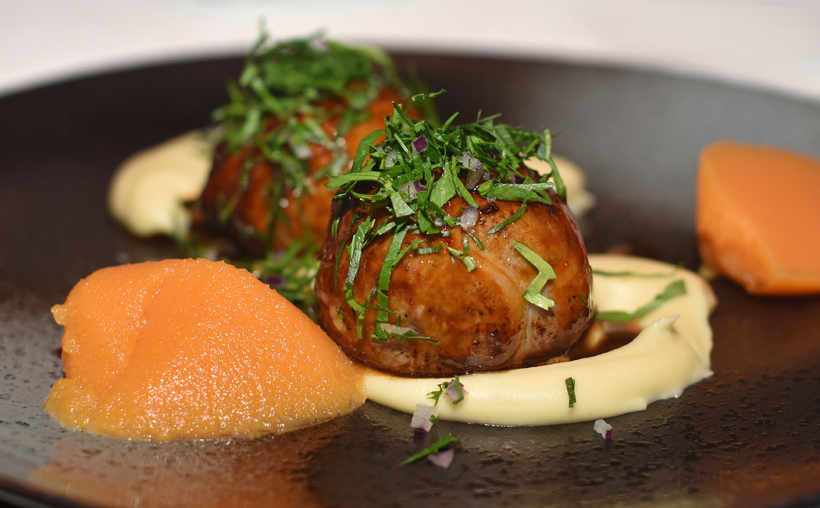
The rabbit tongues, potato, black truffle, and mustard sauce marks the first time I’ve ever seen rabbit tongues in a restaurant. The tiny whole tongues, each about half the size of my pinky finger, are very tender and coated in a little bit of some sauce that goes mostly unnoticed. There’s truffle butter (also on the tongues, I believe), and you can add shaved raw truffle on top, black or white. As you’d expect, the potato purée is very creamy, probably prepared with generous amounts of dairy. The whole dish is sprinkled with black sea salt. Good, but slightly under-seasoned and relatively boring.
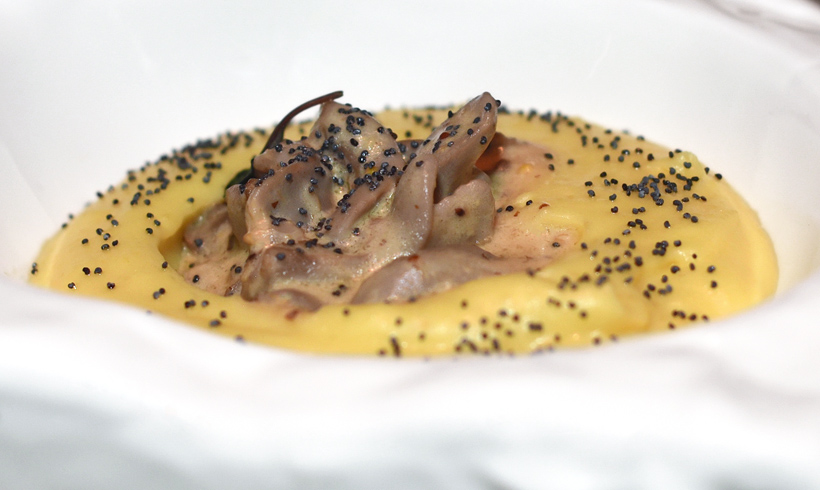
While we skipped dessert, the meal closes with complimentary sea buckthorn spheres. Resting on a bed of fresh sea buckthorn, the bright orange balls have a very thin, hard shell filled with sea-buckthorn juice that explodes in your mouth as soon as you bite in. Not bad at all!

The wine list aims to achieve the same Russian revolution as the food. In a time when many Russians wouldn’t be caught dead drinking Russian wine, preferring below-average imports slapped with astronomical taxes (there are also above-average imports, but the same astronomical taxes reserve them for only the happy few), White Rabbit has an impressive collection of wines from Russia, greatly augmented by the Crimean contingent. Looking for an orange wine? Try the Gewurstraminer Amber Cler Polati from Uppa Winery. It seems to me that some excellent wines from Georgia could have been added to the list, but they’re curiously missing. Among the reds, the fairly full-bodied Fanagoria Saperavi Vintage 2015, made in the Krasnodar region, is one of the best Russian wines I’ve tried, not just pleasant but actually something to seek out.
If White Rabbit’s dining room looks nice on the website, and the views are amazing, be careful if you dine there at night: it’s not visible in my pictures because of my mad photography skillz, but the room is ridiculously dark. This is the kind of place where I had to discover what I ate by looking at my photos when I got home. Compounding the problem, a red light was projected on top of the table where we sat, making everything look, well, red.
Vladimir Mukhin’s cuisine is inspiring, and most of the time very good. Some of the dishes that we picked, maybe out of sheer bad luck, were a bit repetitive and, as a result, boring. Without even realizing it, we ended up ordering four dishes served with root vegetable purées, three of them served in the same kind of bowl and looking almost identical. I also think the restaurant could still gain in quality by offering 30% fewer dishes, and in variety by just rotating them more often. That being said, I love the rare local ingredients and I would totally go back — during day time hours.
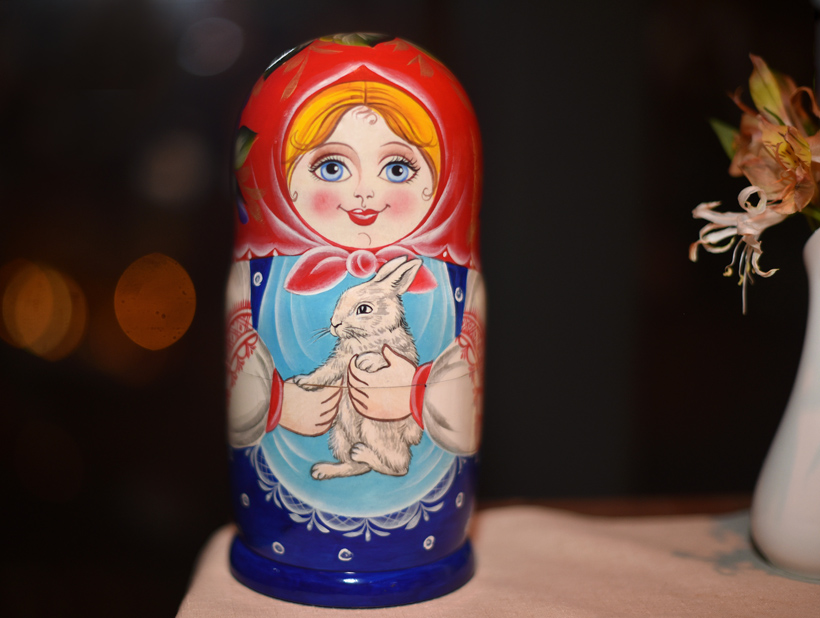
In the interest of sketching out the ingredient space of Russian cuisine, I’ve made a list of all the ingredients that were mentioned on White Rabbit’s menu, and sorted them by categories. Results below!
Savory dishes:
| beef rib, beef tongue, ground beef, filet mignon x2, ribeye, duck, duck breast, foie gras x3, horse meat, Guinea fowl, Guinea fowl livers, hazel grouse x2, Italian sausage, lamb chops, rack of lamb, moose, pork fat, poussin, rabbit, rabbit tongues, veal x2, veal tongue x2, ground wild boar |
| amberjack, burbot, catfish, cod, crucian carps, halibut, cured herring, pike-perch (zander), salmon, salmon belly, sterlet, tench, vendace (small fish) |
| sturgeon caviar x2, Coho salmon roe, pike roe x2, clams, crab, king crab x4, milt, mussels, octopus, oysters, scallops x2, sea asparagus, sea urchin, shrimp x2, king prawns x2, whelk |
| avocado x3, beans (seeds), beet x3, broccoli x2, Brussels sprouts, cabbage x2, cauliflower, celery root, corn, young corn x2, cucumber, eggplant, garden vegetables, pickled gherkin, green peas x2, onion x2, parsley root, potato x5, pumpkin x3, romanesco, sunchoke, tomato x4, scallion, spinach, baby spinach, sweet pepper, zucchini |
| mushroom (no details) x2, aspen mushroom (Leccinum), birch bolete, butter mushroom (Suillus) x2, milk mushroom (Lactarius resimus), morel x3, oyster mushroom, porcini x2, portobello mushroom, black truffle x4, white truffle |
| basil, parsley, sorrel x2 |
| barley, malt, farro, flax seed, rice (risotto), wild rice |
| black pepper x2, curry, mustard x2 |
| hummus x2, miso, truffle oil |
| chimichurri sauce, hollandaise sauce, Mornay sauce, teriyaki sauce |
| butter, cheese, parmesan x3, Stracciatella cheese, egg, sour cream x4 |
| black bread, Borodinsky bread x2, brioche, oladi |
| rigatoni, pasta dough (ravioli) |
| honey, chestnut honey |
| pine nuts, raisins |
| Port wine x2 |
| apple, red apple, grapes x2, mandarins, orange, persimmon, plum |
| bird cherry, elderberry, lingonberry, rowanberry |
Desserts:
| berries, black currant x2, cloudberry, honeysuckle x2, raspberry, strawberry, sea buckthorn, white cherry, wild strawberry |
| apple, Antonovka apple, apricot, mandarin, passion fruit, pear |
| honey, chestnut honey, lavender honey, willowherb honey, salty caramel |
| pine needles, pine nuts, hazelnut, pistachio, young walnut |
| cardamom, chocolate x4, coffee, vanilla x3, dandelion x2, lavander water |
| champagne |
| cheese x2, sour cream x2, baked milk, ryazhenka (fermented milk) x2, moose milk |
| black bread x2, Borodinsky bread, waffle cup |
At the beginning of each season, Vladimir Mukhin creates a new tasting menu, using new products, ideas, and food pairings. Here is what he served in late November 2017 (the ingredients aren’t included in the above stats, because of the repetitions):
Amuse-bouche:
Salty Napoleon with Beluga
Corn milk
Ryazhenka of swan livers and pastilla of Antonovka
Birch bread and forshmak of herring milt and hare
Scallop, raspberry and brined tomatoes
Sea urchin roe, sea buckthorn and sea water
Cabbage and caviar
Tomatoes, grapes and Spanish ham
Cod, malt and sour spelt
Gooseberries and fermented honey
Duck, elderberry and plum
Borodinsky bread, sour cream and sea water
Sea buckthorn pearl
Willowherb tea and willowherb honey
Finally, a YouTube video from Gourmet-Blog, showing the restaurant by day, and various dishes from around the time of my visit:

